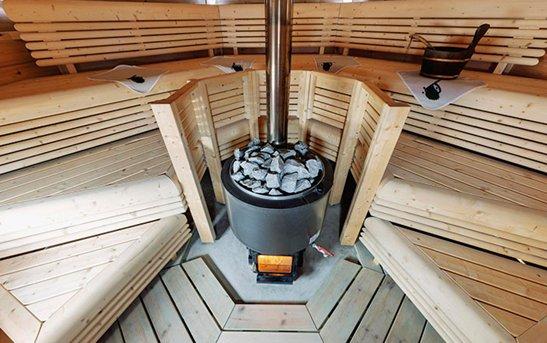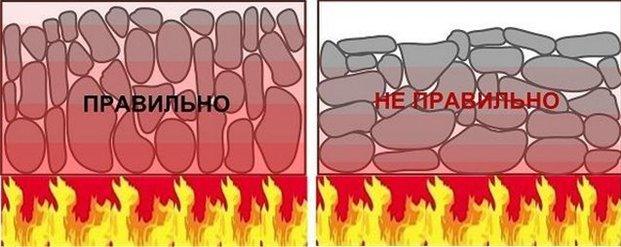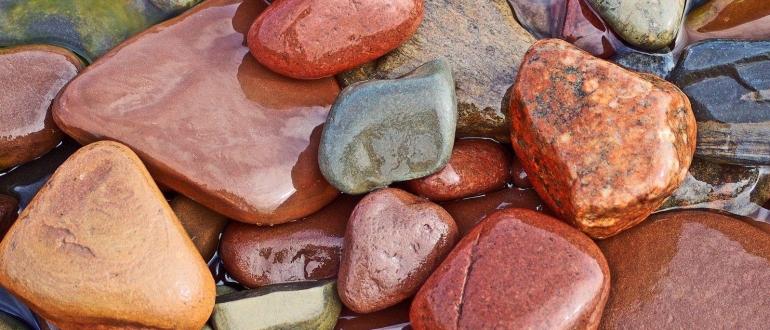A good sauna will be enjoyable and will also have a positive effect on your health. Light steam is the result of a properly assembled heater. The stones inside the steam room accumulate heat and slowly release it. Properly collected rocks, while interacting with liquid, fill the room with useful elements, an unusual smell, and prevents the appearance of various pathological processes.
This effect can be achieved only knowing the properties of minerals, their heat transfer characteristics. They must have a certain strength, high heat capacity, comply with environmental safety requirements and emphasize the aesthetics of the bath. It is extremely important to be aware of the healing qualities of any stone so that the effect of the bath is maximized. To know which stones to choose for a bath, you need to read the recommendations.
Content
Parameters for choosing stones for a bath

When choosing stones for a bath, you need to focus on their appearance, as well as on compliance with some parameters. The main indicators during the selection of stones for bath procedures:
- Resistance of the rock to heat and shock. During use in the bathhouse, stones carry significant loads: initially they are heated to maximum temperature indicators, then they are watered with water, which leads to uneven cooling. Not all breeds can withstand this without losing their original appearance. The higher the heat resistance, the lower the risk of cracking and chipping. It is possible to check the density of the rock yourself: by tapping on the upper layer with a hammer, or by lowering it into chilled water, having heated it in advance. When in each situation it maintains its own integrity, it means a stone of proper quality. The appearance of cracks indicates a low thermal stability.
- The ability to keep warm. It is one of the most important characteristics that stones for bath procedures have. Check by specific gravity - the stone is dense, massive.
- Uniformity of the structure. It is an important indicator of a high quality mineral. Various inclusions on the rock will indicate the presence of an impurity, which is extremely poisonous. When released into the environment during heating, it can cause significant damage to health.
- The form. It is best to choose round flat stones. Such rocks will retain heat better, more likely air circulation is carried out. In addition, flat stones will fit better inside the oven and will have a more aesthetic appearance. The breeds are selected of the same size - large (7-13 cm in diameter) or small (5-6 cm). The choice will depend on the size of the heater.
- The size of the stones. When choosing the required breeds, it should be remembered that specific dimensions are preferable for each type of stove. Breeds should be chosen based not on aesthetic appearance, but on practicality. Large stones of 7-15 cm are optimal for wood-burning stoves, and for electric ones, small stones of 5-7 cm are the best solution.
- Environmental friendliness.Environmental friendliness and safety are considered the key condition during the selection. For example, the rocks that are collected near the railway bed often contain a toxic composition, its vapors will be in the air during heating. When buying minerals in stores, you need to make sure that there is a mark on the package about radiation control.
Due to the constant heating of the heater, its contents will be damaged over time, and the heat transfer will decrease by 20% annually. It is required to check the stones every year, washing them with water and replacing unusable with new ones.
What stones for a bath to choose
Taking into account the type of bathhouse and in what form of the heater the rocks are used, their choice will be determined:
- Russian sauna. During the supply of water to the heated stove, a sudden drop in temperature will occur, the rocks are selected extremely strong, heat-resistant. The most suitable rocks are nephrite, jadeite, pyroxenites. Being formed at great depths under strong pressure, they are characterized by the required strength. Boulders that survived the passage of the glacier are suitable. Useful breeds for bathing procedures are those that create light, finely dispersed steam, retain heat, will not emit harmful elements and create dust.
- Sauna. In it, the tests that fall on the breed are not so severe. Virtually any breed is used that is suitable for Russian baths. But, the use of talcochlorite will be optimal.
- Turkish bath. A characteristic feature is that it is the coldest of any known types of baths. There is no stove here. Steam generators are used to create steam. Therefore, the main use of the breed is as a material for decoration. Marble is ideal for such purposes.
The stone is selected for the bath, starting from what type of heater:
- Closed. It is a chamber that is located in the oven. It will not come into direct contact with the flame, however, significant heating occurs due to the fire from the outside and gases in the furnace. As a result, the rocks in it are subject to destruction. Therefore, only those that have increased strength are required to be used. Jade will last longer than others, due to its fibrous, tangled structure, which does not allow cracking.
- Open. A stove that is fully bathed in flames is the most extreme conditions for rocks. In addition to increased temperature indicators, they are affected by various oxidation processes. In such conditions, everything, even the most durable stones, will collapse. The most economical option is to use inexpensive stones, constantly sorting out and changing the contents of the heater.
- Electrical. Electric ovens are successfully used in Russian and Finnish baths. They are distinguished by their high sensitivity to the size of the placed minerals. The optimal size of the rocks will be no more than 7 cm. All natural rocks that have the heat resistance and thermal conductivity required for a bath are suitable for an electric heater. Jadeite, crimson quartzite, talcochlorite, gabbrodiabase and nephrite are able to withstand multiple heating and cooling cycles.
The timing of the use of stones will depend on the type of stove. This parameter will be affected by impurities, the frequency of use, as well as dimensions.
Types of stones for a bath
Many breeds are known in nature, but only a few are suitable for use in baths. When choosing rocks, it is required to thoroughly familiarize yourself with the characteristics of all minerals. Each of them has its own advantages and disadvantages, which should be considered in order to avoid mistakes and get the expected results. The breeds for the bath are selected taking into account their medicinal qualities, strength, financial resources. It is recommended to change the variety of breeds after 3-4 years, making bath procedures more useful and varied.
Jade

The breed in question is equally well suited for the purpose of falling asleep in the stove and decorating bath buildings. The stone is deservedly called the most suitable for steam rooms. The breed, during the action of elevated temperature indicators, will ionize the air, have a positive effect on blood circulation and the central nervous system, improve tone, and prevent kidney disease. Bath procedures with jadeite are recommended for weather-dependent, those who have difficulties with heart and blood pressure.
Advantages:
- Increased density, which makes it possible to tolerate sudden temperature jumps.
- Durability, the rock will not crumble and crack.
- Long period of use.
- Low coefficient of moisture absorption.
- Can keep warm for a long time.
- The steam formed during the reaction with water has a positive effect on the internal organs and systems, and is useful during diseases of the spinal column.
Disadvantages:
- Overpriced. Therefore, jadeite is stacked on top of more budget stones.
- In everyday life, it is optimal to use chipped.
Talcochlorite

A breed that is capable of retaining its original appearance even at temperatures over 1500 degrees. The stone in question is not very attractive from the outside, but it soon heats up and gives off heat for a long time, it has a high heat capacity and thermal stability. During heating, no harmful elements are emitted, however, over time, dust appears. It has a completely smooth structure and gray color in various shades with a matte sheen. Before laying in the stove, it is recommended to remove dust particles; for this purpose it is necessary to wash and heat the stones.
Advantages:
- An increased concentration of useful components that are released during heating and have a healing effect on the human body. It has a positive effect on the immune system, metabolism, normalizes blood pressure.
- The heat radiation is extremely soft, which makes the steam pleasant and airy.
- Chemical safety.
- Uniform and long-term heat dissipation, in which harmful elements will not be released.
- Resistant to temperature surges.
Disadvantages:
- Overcharge.
- Massive enough.
- Long warm-up.
Gabbro-diabase

A volcanic rock similar to basalt. Differs in proper accumulation and long-term heat dissipation. Resistant to temperature shocks, rarely cracks, moisture absorption is 0.19%. An intermediate link between the gabbro and diabase rocks. The structure is medium-grained, massive, there are no cavities. Dark gray rocks have an oval, somewhat flattened shape.
Advantages:
- Warms up well.
- Environmentally friendly, no harmful substances.
- Low moisture absorption.
- Adequate value.
- Has a healing effect on the respiratory tract.
Disadvantages:
- It takes a long time to warm up.
- Has a tendency to cracking. You will need to constantly sort through the rocks, eliminating the spoiled fractions.
- An unpleasant odor is emitted during heating.
- After drops of essential oils, carbon deposits form on the stone.
- When laying gabbro-diabase, it is necessary to take into account its possibility of expansion when heated.
Porphyrite

This breed is considered one of the most underestimated for bathing procedures. The stone has green, gray, black shades. During the purification of the mineral before each heating, the steam will be thicker.
Advantages:
- It can have a therapeutic effect on the respiratory tract, cleanse the skin, relieve pain in the head.
- It is characterized by increased heat capacity.
- Completely harmless to health.
- It has a long service life without cracking or chips.
Disadvantages:
- During the first heating, a crackling sound will appear, which will disappear over time.
- You will need to constantly rinse and clean the stones.
Raspberry quartzite

Mineral that is able to decorate any steam room due to its own rich purple hue.Formed during the crystallization of sandstone. Includes 90% quartz. When choosing a similar breed, treated specimens should be preferred. Otherwise, over time, the pointed edges crumble and clog the passages. Such a stone has a positive effect on well-being. People who have impaired pressure, painful sensations in the joints are noted, there are difficulties with the work of the heart, hypertension will need to visit a bath with quartz filling. For those who like salty, such a session will also be useful, as the breed will help during the salt deposition.
Advantages:
- It is characterized by healing properties, which help to normalize blood pressure, cure colds, rheumatism, soreness in the muscles.
- Fire resistance. Withstands heating up to 2700 degrees.
- With prolonged use, it will not lose its appearance.
- It has a high density.
- High strength and durability.
Disadvantages:
- Due to its increased strength, the mineral is difficult to process, therefore it is bought only in chipped form.
- Overcharge. Like jadeite, it is placed on top of the rest.
Nephritis

It is a semi-precious rock of a green hue, which is a close relative of jadeite. Also popular for bathing procedures.
Advantages:
- Due to its high viscosity it keeps warm well.
- Structures water, has a positive effect on the human biofield.
- The vapors that form during reaction with water will have a healing effect on the respiratory tract, digestion, and cleanse the body of toxic substances.
- Increased durability.
Disadvantages:
- Overpriced, because it is virtually impossible to find in the store.
- You cannot split the rock with your hands.
White quartz

A translucent rock composed of oxygen and silicon. During the sharp cooling, after the icy liquid hits the hot stove, pure ozone will be released. It is extremely popular among connoisseurs of bath procedures. The concentration of oxygen in this breed will make it desirable for women. During heating, ozone rejuvenates and cleanses the skin, making it healthy.
Advantages:
- Quartz is characterized by the ability to purify breath. At the same time, the therapeutic effect continues for several days after the bath.
- The released ozone rejuvenates the body.
- Looks extremely bright in the oven.
- Environmental friendliness of the mineral.
Disadvantages:
- Sometimes it bursts, unable to withstand temperature jumps.
- It will crack quickly, as a result of which you will need to regularly sort out the stones, removing the damaged ones.
- Difficult to find.
- Overcharge.
How to arrange the rocks in the stove correctly

Quality steam rooms require proper distribution of stones, creating a favorable environment for hot air masses to penetrate. The stones are washed and dried prior to laying.
Laying takes place according to the principle: initially large, then small. When the stones are oblong, they are placed vertically as they tend to heat up.
When working with an electric stove, in the process of laying, gaps are left between stones and tubular heaters. Such a laying method will make it possible to prevent damage to the heating element. The rocks will expand as they heat up, causing the tubes to break.
It is recommended to carry out an “audit” several times during the year: inspecting the contents of the heater for cracks, chips, and their regular replacement. When choosing stones for filling the stove, one must take into account not only their appearance, but also their high heat capacity, resistance to temperature jumps, which have a positive effect on increasing the period of use. Possession of breeds with useful properties that have a positive effect on well-being, will give a pleasant pastime in the bath a health-improving character.
What stones for baths are better to choose

There are certain recommendations that will not make a mistake when choosing filling for stoves in your own steam room:
- When the choice is made between sea and river stones, it is better to choose the latter. Marine are more likely to collapse and will not have high strength indicators, and river ones will withstand increased temperature indicators much longer.
- The shape of the rocks will depend primarily on the wishes of the user. When it is necessary for the laying to give a large amount of steam, and also to have a pleasant appearance, then the most beautiful stones of the corresponding shape are laid on top.
- When the user is not sure which rock to choose and how many stones to put inside the oven, then read the instructions that come with the package. It should contain information about the number of stones for the bookmark, about the healing properties that any mineral will have.
- When the user wants to collect stones himself, it is optimal to do it in the field. The "field" stones were hardened by different weather conditions, so temperature fluctuations in the furnace are tolerated without difficulty.
- The stones should be rounded and smooth. The presence of cracks and chips leads to early cracking during heating.
- The structure of the mineral must necessarily be uniform. If there are impurities and inclusions, the rock will quickly crack or burst in the furnace. In addition, various impurities, for example, iron oxide, are capable of releasing harmful elements during heating.
How much are the stones for the bath

To know how to choose stones for a bath yourself, you need to familiarize yourself with the value range:
- Of the stones bought in stores, the most budgetary are gabbro-diabases. It is recommended to use them on a limited budget. They have indicators suitable for a heater at an affordable price. The sulphides are the cause of the unusual aroma that spreads from the stones during heating. It is possible to avoid this difficulty when inspecting the breed prior to acquisition. The cost will be 25-35 rubles. for 1 kg.
- Jade and jadeite are available to a narrower circle of buyers. The cost for 1 kg sometimes reaches 250 rubles.
- There is also a free solution - ordinary pebbles, which can be found by the reservoir. It includes a variety of breeds that are suitable for use in baths. However, pebbles do not have any therapeutic effect on the body.
- Observing certain recommendations, it is possible to increase the life of the stones. For these purposes, you should not heavily water the rocks with water, a small portion is enough, but after a short period of time. It is recommended to pour hot water onto the stove to avoid sharp popping.
Often they ask themselves how to choose stones for a sauna heater. To find out how to get the best product, please read these guidelines.



